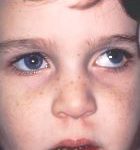Strabismus
Strabismus is a misalignment of the eyes. The condition occurs in 4% of the population for both children and adults. Strabismus is often referred to colloquially as “lazy eye,” but this term is also applied to different medical conditions including eyes with poor visual development (amblyopia) and droopy eyelids (ptosis).
The impact of strabismus on visual development depends on the age of onset. Generally speaking, younger patients require faster intervention to prevent long term damage. Some types of strabismus can cause children to have poor visual development in one or both eyes. In particular, depth perception and motor fusion will not develop normally if the eyes are misaligned. The urgency of treating strabismus depends partly on whether a child is within a critical period of visual development.
The video below provides a good overview of strabismus from the persepective of an ophthalmologist.
What causes strabismus?
Often the root cause of strabismus is not within the eyes, even though the primary symptom is eye misalignment. Strabismus is typically due to a problem between the brain and eye muscles that results in a difficulty maintaining proper eye positioning. In children over the age of six months, this condition needs to be evaluated by a pediatric ophthalmologist, as it will not resolve without proper treatment.
What different types of strabismus exist?

Esotropia: eye turns in toward the nose
When an eye is turning inward that is known as an “esotropia.” This can be due to a variety of reasons ranging from a large far-sighted glasses prescription to over-stimulated eye muscles.

Exotropia: eye turns in toward the nose
Exotropia refers to the eyes drifting apart from each other. Eyes may drift outward more often when the person is fatigued or daydreaming. Symptoms of exotropia include eyes drifting outward, light sensitivity, and decreased vision.

Hypertropia: eye turns up
Hypertropia (upward moving) refers to a vertical misalignment of the eyes. Hypertropia occurs when one eye is elevated too high. There are various causes for vertical imbalances including but not limited to medications, systemic diseases, and trauma.

Hypotropia: eye turns down
Hypotropia (downward moving) refers to the vertical misalignment of the eyes. Hypotropia occurs when the affected eye deviates too low compared to the other eye. Similar to hypertropia, there are various causes for this kind of vertical imbalance including medications, systemic diseases, and trauma.
How is strabismus treated?
Depending on the cause and type of strabismus, the condition may be treated with eye glasses, prisms, eye exercises, eye patching, or surgery. Not all types of strabismus are necessarily candidates for all types of potential treatments. Treatment plans are always individually designed based on a patients’s age, symptoms, and history.
Strabismus surgery
For some patients, surgery is the best option for improving their eye alignment and improving their vision. Strabismus surgery involves adjusting the position or strength of one or more of the six muscles that attach to each eye. Adjustments to the muscles that move the eyes can help the eyes move together in unison with better alignment. This can improve depth perception and motor fusion which are important parts of the visual development. This can improve neurodevelopment regarding visual development, improved motor coordination, and impact developmental milestones and associated neurodevelopment.
